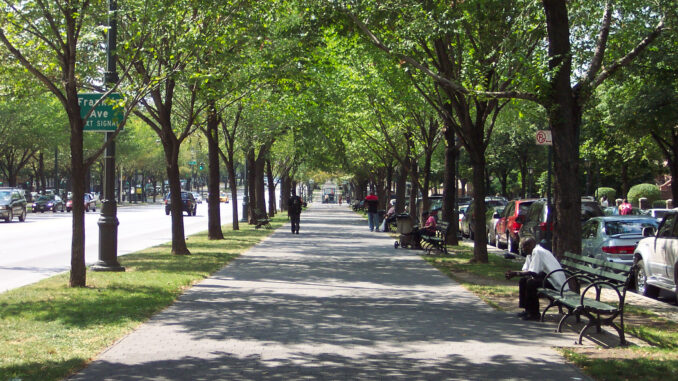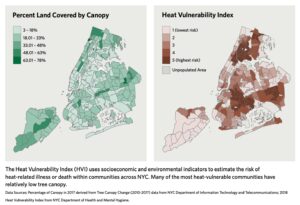
BY DIANA BAUTISTA
Being one of many low-income communities in Brooklyn, Bushwick faces exceptional environmental hazards, one of which is the lack of canopy. One non-profit organization, Trees New York, is addressing the challenges by planting trees in treebeds around neighborhood schools, libraries, playgrounds, parking lots, and walkways.

The neighborhood exhibits a canopy coverage range of 16-32 percent, coupled with a heat vulnerability ranking of 2-3, according to The Nature Conservancy organization. This is close to city averages but not enough to deal with the increasing pollution and heat waves that have been occurring for multiple years. The data underscores the pressing need for targeted initiatives to address environmental disparities and enhance the overall well-being of Bushwick residents.
In a city that’s filled with pollution from vehicles, experiences heatwaves with unpredictable weather, and faces environmental risks, trees play a hugely essential role in New York City. The urban forests provide multiple benefits for those who live in such an environment, including benefits for human health and the mitigation of climate change. They increase community resilience and assist neighborhoods that lack green and open space.
Nelson Villarrubia, the Executive Director of Trees New York, a nonprofit organization since 1980 and a leading advocate for tree stewardship in New York City, said the organization has consistently worked on growing and expanding the tree canopy throughout the city. This initiative provides much-needed shade, contributing to the cooling of these spaces. Over the last five years, they have successfully planted over 5,000 trees, with 2,000 planted in 2023.
“We see that trees not only add beauty to a space but they are also critical aspects of a green infrastructure in our city,” Villarrubia said. Among their many benefits, he said, they reduce urban heat, influence stormwater management, provide shade and cooling, and improve air quality. “We planted trees near Irving Park and some other areas nearby,” Villarrubia said. When they planted a tree in Bushwick, they invited community members to come out, participate, and observe. “We do community engagement projects with our tree planting.
“It can take a year for the Parks Department to get to the spot being requested so it’s not something that happens right away,” he said. When the group is getting ready to plant, they email everyone that lives around the area. In Bushwick, Councilmember Sandy Nurse posted flyers on social media. They also focus on libraries and schools, engaging in conversations with other non-profit organizations in the area to enhance their general outreach.
Wyckoff Avenue is one of the multiple streets that need a tree canopy. From Himrod Street to Hart Street, there are only two trees on each end of the street. Additionally, three streets in this area have no trees at all. Air quality in the area is especially important given that Wyckoff Heights Medical Center’s emergency room is situated between Stanhope Street and Himrod Street.
Bry Jones is a resident of Bushwick who decided to move from Long Island to Brooklyn and has seen a huge change in the way the environment and scenery look, as well as the air quality.
“I suffer from asthma so having good air quality is very needed for me.” She added, “The air quality isn’t as bad as other places in Brooklyn, but it can definitely be better.”
According to a November 30 article in The Guardian, New York City has been seeing canopy growth since last month, when the City Council passed a measure calling for a 30 percent canopy cover by 2035, up from its current cover of 22 percent.
